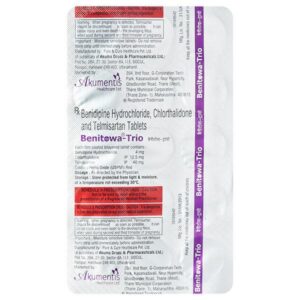CHLORTHALIDONE + BENIDIPINE + TELMISARTAN
Chlorthalidone: Chlorthalidone is a medication that belongs to the class of drugs known as thiazide diuretics. It is primarily used to treat high blood pressure (hypertension) and fluid retention (edema) caused by various conditions, such as heart failure, kidney disease, or liver cirrhosis.
The primary mechanism of action of chlorthalidone is to increase the excretion of sodium and water from the body by inhibiting the reabsorption of sodium in the kidney. By doing so, it helps to reduce the volume of fluid in the blood vessels, which leads to a decrease in blood pressure. Additionally, chlorthalidone may also promote vasodilation, further assisting in lowering blood pressure.
Chlorthalidone is usually taken orally as a tablet, and the dose varies depending on the condition being treated. For hypertension, the usual starting dose is 25 milligrams (mg) to 50 mg once daily, taken in the morning. This can be adjusted based on individual response, and higher doses, up to 100 mg, may be prescribed if necessary. For edema, the typical starting dose is 50 mg to 100 mg once daily, usually in the morning.
While generally well-tolerated, chlorthalidone may cause certain side effects. Common side effects include increased urination, dizziness, muscle cramps, low potassium levels (hypokalemia), low sodium levels (hyponatremia), increased blood sugar levels (hyperglycemia), and low blood pressure. Less frequently, individuals may experience allergic reactions, skin rashes, digestive disturbances, and changes in blood lipid levels.
It is essential to note that chlorthalidone may interact with other medications, such as lithium, nonsteroidal anti-inflammatory drugs (NSAIDs), and certain antidiabetic drugs. Therefore, it is crucial to consult a healthcare professional before starting or adjusting the dose of chlorthalidone, especially if already taking other medications or have any pre-existing medical conditions.
Overall, chlorthalidone is an effective medication for managing hypertension and fluid retention, with a well-established mechanism of action. It is commonly used in combination with other antihypertensive drugs to achieve optimal blood pressure control. However, like any medication, it is necessary to monitor for potential side effects and seek medical attention if any significant concerns arise.
Benidipine: Benidipine is a medication primarily used for the treatment of high blood pressure (hypertension). It belongs to the class of medications known as calcium channel blockers. Benidipine works by blocking the entry of calcium ions into the smooth muscle cells of blood vessels and heart which is necessary for muscle contraction. As a result, it causes the blood vessels to relax and widen, making it easier for blood to flow through them, and reducing blood pressure.
The usual recommended dose of benidipine for adults is 4 to 8 mg per day, taken orally. The dosage may vary depending on the individual’s response to treatment and the severity of their condition. It is typically taken once daily, preferably in the morning with or without food.
As with any medication, benidipine may have side effects, although not everyone will experience them. Common side effects can include dizziness, headache, flushing, ankle swelling, and peripheral edema (swelling in the limbs). Some individuals may also experience fatigue, palpitations, nausea, abdominal pain, constipation, or rash.
Rare but more serious side effects can include severe allergic reactions, chest pain, irregular heartbeat, and shortness of breath. If any of these serious side effects occur, it is important to seek medical attention immediately.
Before taking benidipine, it is important to inform your healthcare provider about any other medications you are taking, as well as any medical conditions you may have, especially kidney or liver diseases. It is also important to avoid alcohol while taking benidipine as it may increase the risk of side effects.
Overall, benidipine is an effective medication for managing high blood pressure by relaxing the blood vessels and improving blood flow. However, it is necessary to use it under the supervision of a healthcare provider and follow their prescribed dose to ensure its safe and effective use.
Telmisartan: Telmisartan is a medication that belongs to the class of angiotensin II receptor blockers (ARBs). It is commonly prescribed to treat high blood pressure (hypertension) and prevent related complications.
The mechanism of action of Telmisartan involves blocking the action of angiotensin II, a hormone that causes blood vessels to narrow. By blocking the angiotensin II receptor, Telmisartan relaxes and widens blood vessels, which helps to lower blood pressure. It does not inhibit the breakdown of bradykinin, a peptide that also plays a role in blood pressure regulation.
The usual starting dose of Telmisartan for hypertension is 40 mg once daily. The dose may be increased to 80 mg if further blood pressure reduction is needed. It can be taken with or without food.
As with any medication, Telmisartan may cause side effects. Common side effects include dizziness, headache, back pain, sinusitis, and diarrhea. Less common side effects may include allergic reactions, chest pain, rapid or irregular heartbeat, muscle pain, and urinary tract infection. It is important to discuss any concerns or side effects with a healthcare professional.
Telmisartan may interact with other medications, so it is essential to inform your healthcare provider about all the medications you are taking. It is usually not recommended during pregnancy or breastfeeding.
Overall, Telmisartan is a widely prescribed medication that effectively lowers blood pressure. However, it is important to follow the prescribed dose and seek medical advice if any side effects occur.


